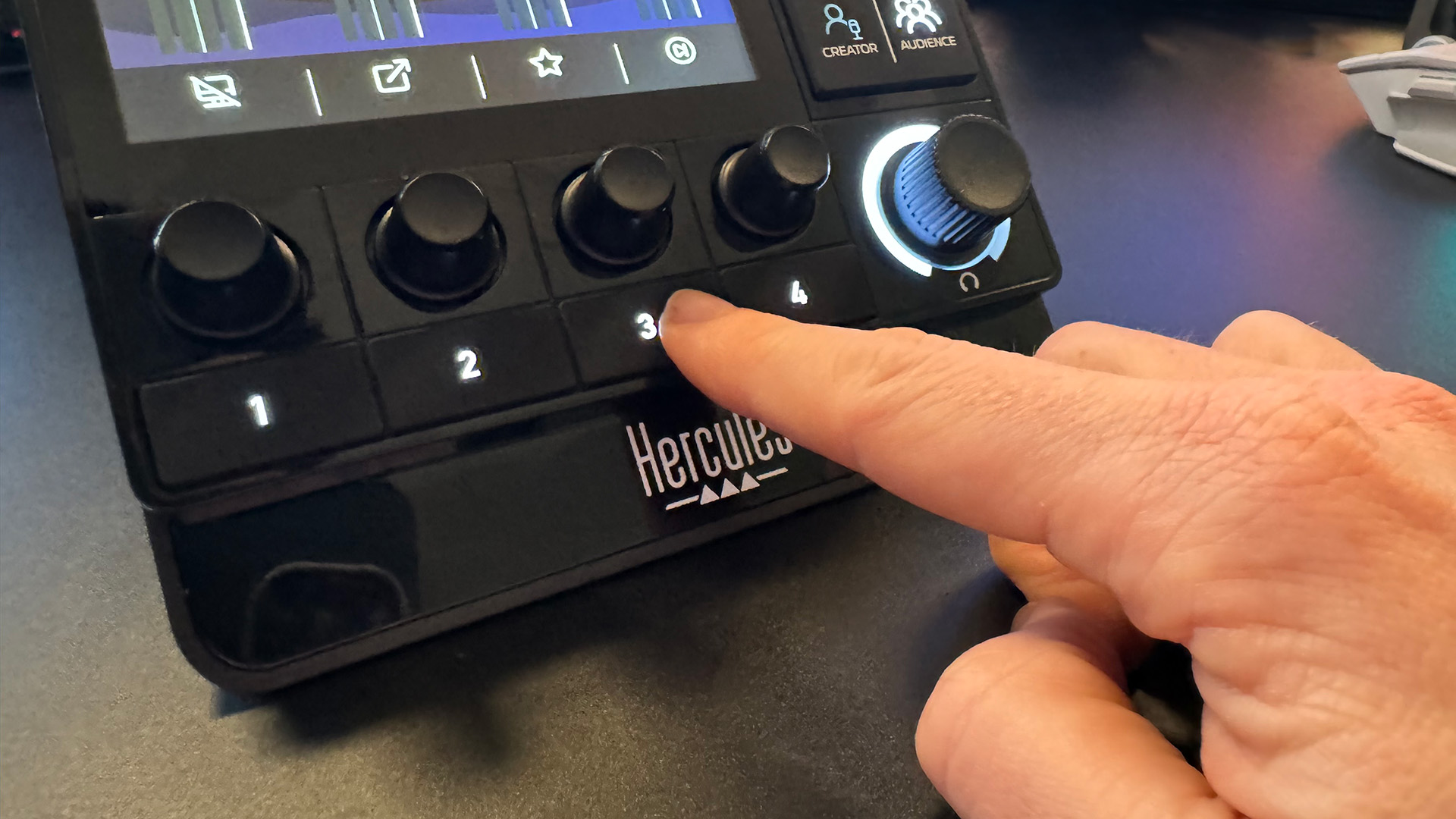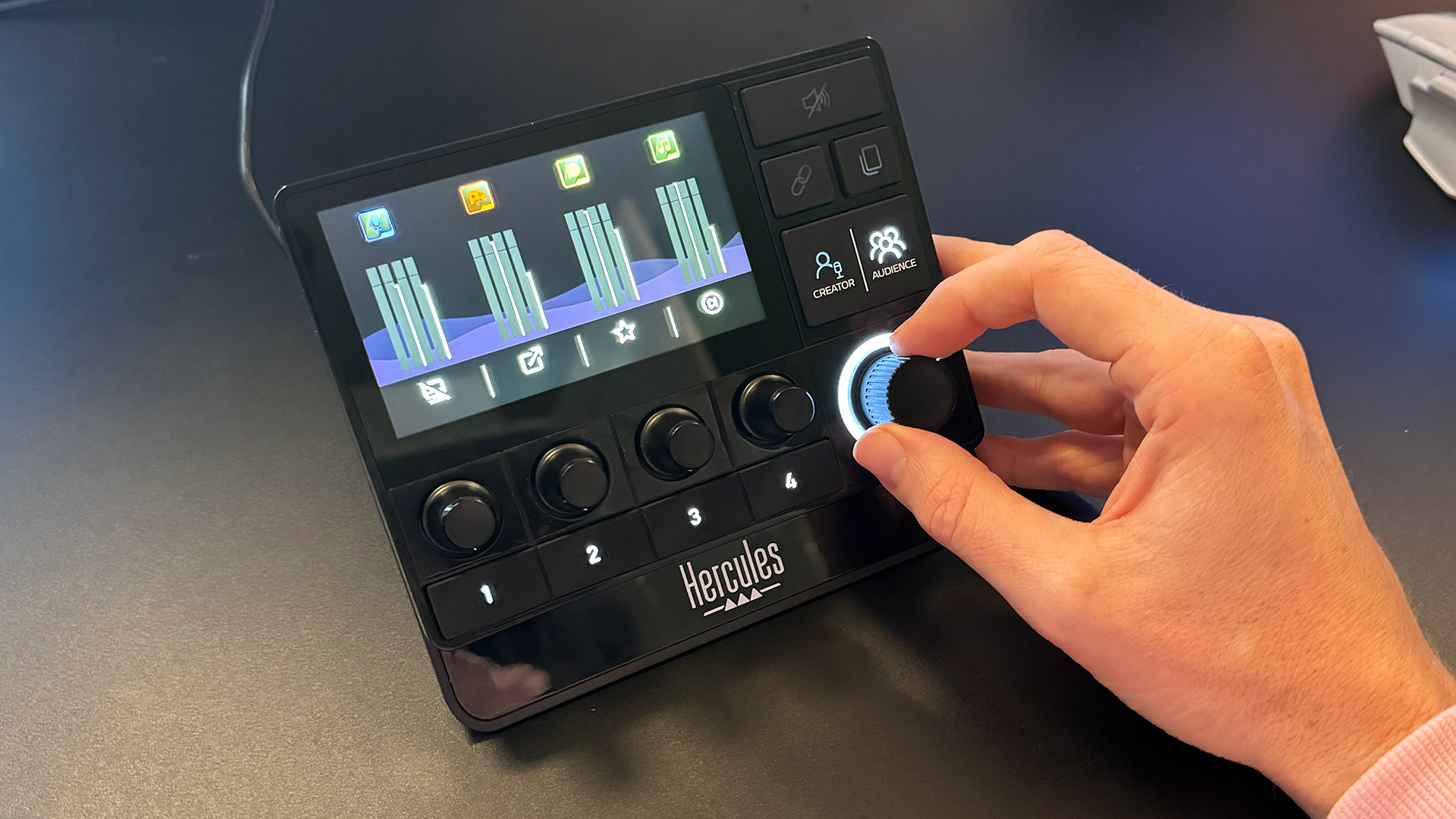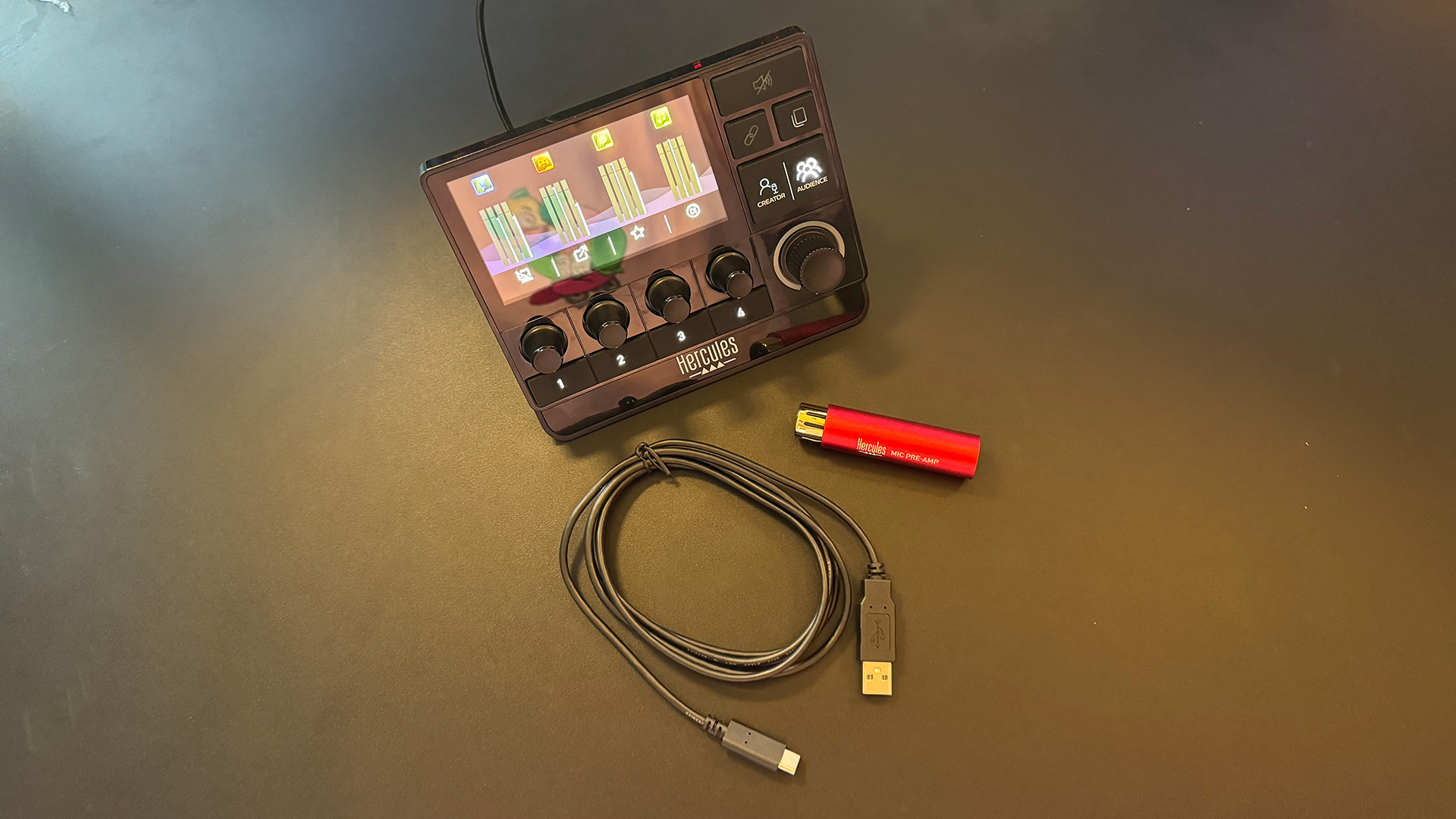GamesRadar+ Verdict
Like its smaller sibling, the Hercules Stream 200 XLR misses the mark. This isn't a brand that typically strays into the gaming hardware scene, and it shows. The 200 XLR will deliver clean audio with a decent microphone thanks to the audio heritage of its maker, but it isn't the utility belt gadget streamers want to have on hand.
Pros
- +
Clean XLR microphone output
- +
Bright, clear LCD screen
- +
Creator and Audience sub-mixes
Cons
- -
Relies on stock Windows channels
- -
Limited button functionality
- -
Submix outputs aren’t digitally available
- -
Average build quality in places
Why you can trust GamesRadar+
As streamers progress through their journey from beginner to seasoned veteran, most will look to make the jump from a USB microphone to an XLR setup. Grabbing a decent microphone is a good start, but if XLR is the route you want to take, you’ll need to think about an audio mixer like the Hercules Stream 200 XLR to plug it into.
You could go with a basic audio interface like the RODE AI-1; or to take greater control of your audio it’s a streaming-oriented audio controller you’ll want to turn to. There are a few options in the market already like the BEACN Mix Create and Razer Audio Mixer, but now Hercules has entered the game with the Stream 200 XLR.
The brand may be a newcomer to the world of streaming - you certainly won't find them on our list of the best capture cards, for example. But with a background in DJ equipment and other gadgets for musicians, Hercules should have plenty of knowledge to fall back on. It’s still a new area for the brand though, so if you’re a streamer looking to beef up your setup is it worth taking a punt on Hercules or should you stick to a more established brand?
Design & Features

Joining the market alongside the cheaper and simpler Hercules Stream 100, the Stream 200 XLR follows the same overall styling. In fact, looking at it from the front, it’s more of a Stream 150 with a new panel of four buttons and a wheel bolted onto the side of the Stream 100's interface. These additions increase the footprint by around 50% and make it a considerably less compact unit, but given it’s now doing the work of two devices that’s to be expected.
The same 4.3” LCD screen, dials, and buttons carry over from the Stream 100 with no change to their appearance, layout, or functionality. The dials lack any sense of quality with their hard molded plastic construction and no grip texturing, though the rubber buttons below them feel great with a short, clicky interaction and backlit numbers. The display quality is impressive for what it is, the screen is bright with nicely saturated colors and enough resolution to be clear; though perhaps a little crunchy on smaller text labels. Like the Stream 100, there’s no touch functionality on the Hercules Stream 200 XLR which is a shame, I’d like to have seen some basic levels of interaction here given the steeper price point.
The Stream 200 XLR’s new additions include a mute all button, a link button for simultaneously changing levels across both submixes, a dedicated page management button, a submix toggle, and a headphone volume dial. The rubber buttons carry the same short travel distance but I had real trouble with the creator/audience submix toggle. It’s the largest button on the device but only the middle third will actually acknowledge a push, poking at any other part fails to register an input which renders the size of the button useless and irritating. The whole unit does feel noticeably more solid and weightier than the smaller Stream 100, but pressing the top buttons causes the front of the Stream 200 XLR to lift up and sometimes won’t fire off as a result; that's not what you need mid-stream.

The chunky headphone volume dial does gain some ribbed grip texturing which is a step up from the four others it sides with, though the quality overall still remains disappointing. I was able to wiggle the dial 3 or 4mm back and forth without registering a change and when I did completely turn it movement felt rough and raw. The LED ring around the dial will fill with light as you turn the wheel which is nice but given it’s not a free spinning wheel I’d have liked to have seen a physical indicator on there as well as the LED ring isn’t particularly precise.
Around the back of the Hercules Stream 200, you’ll find an XLR input with phantom power, optical, and line-in as well as headphone and USB-C outputs. There’s no preamp inside the Stream 200 XLR however Hercules does include an external one. Together it’s a nice I/O setup that should cater to the needs of most content creators rocking one of the best microphones for streaming and gaming. It’s not a cramped arrangement but there feels like a lot of blank back panel space that could have given each input more room to breathe and made making changes with a full house of cables a little simpler.
Performance

I was critical of the smaller Hercules Stream 100 because it lacked some of the basic audio management features you’d expect to see on a streaming-focused controller. A number of these holes have been filled with the Stream 200 XLR but sadly a few new cans of audio worms come along with it.
The transition from controller to interface with the addition of those three audio inputs makes a huge difference to the value of the Stream 200 XLR as it saves the need for a second unit just to connect an external device. I tested it with a RODE PodMic and was happy with the results, though it will require that external preamp and onboard phantom power to produce decent gain levels. The audio it delivered was clean, but only a handful of basic EQ and processing options are available in the Hercules Stream Control app. Bizarrely, the physical 48V switch is overridden by the software choices available in the app which had me scratching my head wondering why things weren’t working for a few minutes. It rather defeats the purpose of a physical switch if you can’t trust its position and it doesn’t speak to its own app.
The opposite of the Stream 100, which only allows for the binding and control of individual audio sources, the Hercules Stream 200 XLR only allows for control of five bundled audio channels that it’ll install for you; game, chat, music, system, and aux. It feels like a backward step to actively remove functionality on a more expensive option, surely allowing for control of either individual apps or a channel would have been more useful. You’ll also need to use the stock Windows audio mixer to allocate individual apps to these channels, there’s no Hercules drag-and-drop interface which frankly makes it a chore to do. When you have labored away assigning individual apps to each group though the experience is actually a smooth one. The LCD screen allows for easy monitoring and balancing of levels and the act of adjusting input levels across both the creator and audience submix is intuitive.

Having unique submixes for what I hear as a creator and what my audience hears is excellent and something that's hard to lose after using the BEACN Mix Create. Annoyingly, the Stream 200 XLR’s implementation of this feature simply isn’t excellent, at least in my setup anyway. The device doesn’t produce digital outputs of the two submixes, rather they’re seen by Windows as audio inputs. This means running them into OBS is fine, but running them digitally to USB speakers isn’t an option. In my setup that meant either being limited to headphones or running a cable from the Stream 200 XLR to my SteelSeries Alias 7 speakers’ line in port. It’s a frustrating limitation that forces you to go all-in on organizing your audio sources as anything not assigned to a Windows audio channel simply won’t be heard.
You’re still limited to just two pages of actions on the Hercules Stream 200 XLR but this time the dedicated page swap button means you’ll keep all four buttons assignable, unlike the Stream 100. The Stream Control software offers basic Windows and media playback options, along with integrations for OBS and Streamlabs. However, without a marketplace or the ability for custom inputs or hotkeys, the functionality of these buttons is left wanting. Even the list of native functions feels like it’s short of a few basic choices; there’s an option to launch a URL but not to launch an app and no way to trigger sound effects outside of OBS. It all feels half-baked, something you don’t want to see from a £250 product. Thankfully, all of this is software side so could be expanded on and improved in the future but for now it’s just not up to the level it needs to be.
Should you buy the Hercules Stream 200 XLR?

Like the smaller Stream 100, the Hercules Stream 200 XLR shows promise but ultimately doesn’t deliver a compelling enough package to outshine existing options from other brands. This combined audio interface and controller aims to take the hassle out of audio management but in my testing it just ended up causing more problems than it solved.
Purely as an XLR interface the performance is good but there are cheaper and more feature rich interfaces out there for those just looking to connect a microphone. All isn’t lost for Hercules though as the base hardware is there, it just needs a better user experience to unlock its potential. For now, it’s tough to recommend and you’d be better off exploring other choices in the list of best gear for streamers.
How we tested the Hercules Stream 200 XLR
I included the Hercules Stream 200 XLR in my streaming and gaming setup for a week. In this time I used it as my primary audio interface for live streaming, connecting a RODE PodMic via the included external preamp.
To learn more about the ways we test gaming accessories and streaming gear, have a peruse of our hardware policy.
Looking for more buying advice for content creation? Take a look at the best webcams, the best ring lights for streamers, and the best green screens.
Alex is a streamer who has been creating gaming content for over a decade, streaming on Twitch regularly across the last five years. With a degree in film and a background in sports media, you'll find him jumping between 60,000 seat stadiums and his Animal Crossing island (where he's growing pears, in case you were wondering).




